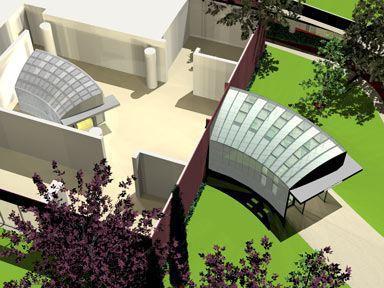ReModeling
dal 26/1/2004 al 18/4/2004
Segnalato da
26/1/2004
ReModeling
University Art Museum, Long Beach
New Ideas on the Form and Function of Architectural Models. An exhibition of work by Leo Saul Berk, Barbara Bestor, Taft Green, and David Schafer that considers the architectural model as a form that makes us rethink the ways in which we relate to the world around us.

New Ideas on the Form and Function of Architectural Models
Leo Saul Berk, Barbara Bestor, Taft Green, and David Schafer
The University Art Museum presents an exhibition of work by Leo Saul Berk,
Barbara Bestor, Taft Green, and David Schafer that considers the
architectural model as a form that makes us rethink the ways in which we
relate to the world around us. A focused group show organized by Mary-Kay
Lombino, Curator of Exhibitions, this exhibition is a continuation of the
museum's interest in issues related to architecture, which demonstrates our
commitment to showcasing all forms of contemporary visual culture and our
interest in the instrumental role that innovative architecture and design
play in enriching our environment.
Following Under Construction, our spring 2002 exhibition, this spring we are
presenting Re-modeling from January 27 - April 18. Since the dawn of
Minimalism, artists have been wrestling with the issue of architectural
space and the ways in which three-dimensional art objects can shape the area
around them through a perceptual investigation of space. Expanding on this
tradition, the work included in ReModeling investigates the role of models
in the process of assessment, and places value on expanding the bodily
experience of space and how it differs from perceiving two-dimensional
representations of space. The sculptural work of Taft Green and David
Schafer reminds us that spatial perception is always a process of
interpretation, while Leo Berk and Barbara Bestor create models that
simulate actual experiences with an emphasis on the role of materials and
environment in determining our understanding of a space or a structure.
Seattle-based artist Leo Berk presents a new life-size model designed
especially for the Court Gallery of the UAM. The model is a redesign of the
UAM facade, which transforms the ordinary museum entrance into a grand,
light-filled hallway leading to the front doors. The piece is constructed
entirely of fluted polypropylene, a material commonly used by architects for
fabricating small-scale models. By blowing up a miniature model to the size
of an actual room, Berk allows the viewer to experience a Leo Saul Berk,
Long Beach Above, 2003, computer rendering fully by entering inside the room
within a room.
Barbara Bestor a Los Angeles-based architect recently named in Artforum's
"Top Ten" is interested in how models allow her design process to expand as
she work's through her ideas. Three concept models for the architect's home
in Echo Park will be presented in a room in which all the walls will be
plastered with her super-graphic wallpaper designs inspired by LA freeways,
plywood, and Spanish moss. The models and the wallpaper together highlight
Bestor's interest in surface and the ways in which the exterior shell of a
building can often communicate a great deal through texture, color, and
material presence.
Taft Green, a recent graduate from the Art Center School of Art and Design,
is represented by three works in a recent series entitled Continual
Distance. Here, Green combines his interests in building and cognitive
theory to create sculptures that map out human perception of objects in
everyday life such as a checkout counter, a staircase, an intersection, or a
city block. He is interested in the frame of reference we use to locate
ourselves within a context. Using models of architecture, and examining
models of experience, he renders shifts between abstraction and recognition
that occur in the way we understand our surroundings.
Los Angeles-based artist, David Schafer, will present a large-scale
sculpture and related 3D-renderings that show evidence of his sustained
interest in the interpretive tools we use to decipher our surroundings. The
sculpture, a fifteen-foot high tower of eye-beams inspired by a found still
image, recalls the monumental abstract work of Mark Di Suvero. However, it
is imbued with the artist's acute sense of post-modern irony and critique of
everything from contemporary architecture and modernism to popular culture
and vernacular design.
Reception: February 28, 12-2pm (see additional special events below)
All events are open to the public and free of charge, donation requested.
Tuesday, Wednesday, Friday, 12-5pm; Thursday, 12Â8 PM; Saturday, Sunday, 11
AMÂ4 PM, closed Monday and all University holidays
Image: Leo Saul Berk, "Entry Proposal for UAM (evening exterior view)", 2004,
16 x 20', archival pigment print on arches paper.
EVENTS:
Contemporary Discovery IV: Models of Experience | February 28, 2:30 Â 4:30
pm Free, call 562.985.7000 for reservations and tickets | CSULB Student
Union Beach Auditorium
This symposium brings together five professionals in the fields of art and
architecture to discuss the shifting role of the model today in the creative
process and alternatively, as a tool in perception, cognition, and
communication. The panel will focus on experimental and interdisciplinary
projects, collaborations between artists and architects, and the lapse
between process and finished product.
2004 Zeitlin Lecture featuring Jorge Pardo | February 28, 5 pm Tickets
$12.00, call 562.985.7000 for reservations and tickets | University Theatre
DIRECTIONS:
>From the 405, 605, and 22 Freeways, exit 7th Street/22 West. Turn right on
Bellflower Boulevard and right on State University Drive. Turn left on
Merriam Way. Metered parking is available on the right in Lot 17. Permits
are required for all other areas and can be purchased at the yellow
dispensers located in the parking structure and throughout the parking lots.
The University Art Museum is located in the Steve & Nini Horn Center on the
campus of California State University, Long Beach
1250 Bellflower Boulevard, Long Beach, CA 90840
Contact: Sarah G. Vinci, Community Relations Coordinator, (562) 985-4299



